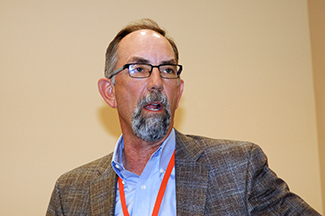A Prime Target for Cloning
West Texas A&M researchers propagate Prime YG 1 carcass through cloning and embryo transfer.
by Troy Smith, field editor
BROOKINGS, S.D. (June 20, 2019) — “We brought a dead steer back as a live bull; so that’s pretty cool,” grinned animal scientist David Lust, as he described the PrimeOne Project for an audience gathered during the Beef Improvement Federation Annual Convention hosted June 18-21 in Brookings, S.D. In a presentation to the Advancements in End Product Improvement Committee, the West Texas A&M University instructor and researcher told about the project’s use of cloning technology to further production of USDA Prime, Yield Grade 1 (YG 1) beef carcasses.

David Lust
“We brought a dead steer back as a live bull; so that’s pretty cool,” said West Texas A&M University Animal Scientist David Lust in describing the PrimeOne Project. [Photo by Troy Smith]
Lust said carcasses grading Prime, YG 1 are ideal because they offer the taste fat (marbling) without the waste fat that’s trimmed away. However, because quality grade and yield grade are antagonistic traits, the ideal combination is rare, occurring at the rate of one per 3,333 beef carcasses. The project was designed to test whether like produces like when mating animals cloned from Prime, YG 1 carcasses.
According to Lust, the cloning process involved replacing the nucleus of a donor cow’s oocyte with cultured DNA from a muscle tissue sample taken from an “ideal” carcass. The first cloned animal was Alpha, a bull born in 2012, followed by cloned females (Gammas). Embryos flushed from Gammas bred to Alpha produced the first calves resulting from mating the cloned animals.
Researchers collaborated with Cactus Feeders’ Kansas cow-calf operation, breeding commercial cows to Alpha and three competitive sires (Angus, Charolais and Simmental) to compare progeny. Lust reported that Alpha-sired calves exhibited the largest longissimus muscle area and lowest yield grade next to the Charolais sire. Alpha-sired calves also represented the highest value per hundredweight.
Progeny testing has continued with the inclusion of calves sired by AlphaGamma 1, a son of Alpha. Lust said results will be available after July 10, 2019, but preliminary data suggest AlphaGamma 1 progeny are yielding more Prime carcasses and more YG 1 carcasses than Alpha progeny.
“I think we can conclude that cloning is a viable option – a tool for preserving rare terminal sire genetics,” stated Lust. “Cloning has limitations though, including high expense and low efficiency.”
The 2019 BIF Annual Convention was hosted by South Dakota State University and the South Dakota Beef Breeds Council June 18-21 at the University Comfort Suites and Convention Center in Bookings. ANGUS MEDIA® provides comprehensive online coverage of the event at www.BIFconference.com. Visit the Newsroom for summaries, proceedings, PowerPoints, video and/or audio of the sessions and the Awards page for announcements and photos of award winners.
Editor’s Note: This summary was written under contract or by staff of ANGUS MEDIA®. Through an agreement with the Beef Improvement Federation,
we encourage reprinting of the articles to those who will adhere to the
reprint guidelines available on this site. Please review those
guidelines or contact Shauna Rose Hermel,
editor, at 816-383-5270. PowerPoints are posted with permission of the
presenter and may not be reproduced in whole or in part without the
express permission of the presenter. We welcome educational venues and
cattlemen to link to this site as a service to their audience.
For questions about this site, or to notify us of broken links, click here. Look for additional coverage in the Angus Journal, the Angus Beef Bulletin, the Angus Journal Daily, the Angus Beef Bulletin EXTRA and Angus TV.


